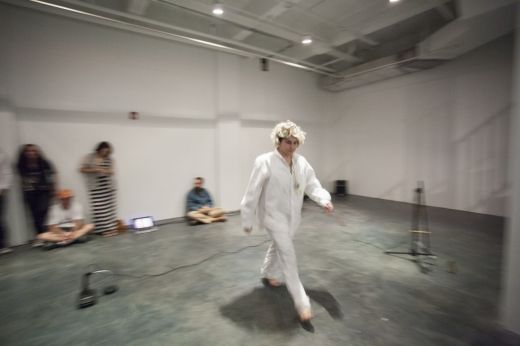Matter is a Word, a Noise: Dawn Kasper at Cannonball
Martha Raoli

Dawn Kasper performing at Cannonball.
Eight o’clock. Kasper tinkers with a loosely assembled orchestra of digital–to–analogue technologies. Throughout the vast space—between tape recorders, amplifier, radio, record player, laptop positioned along the floor—she twirls knobs and tweaks dials with one hand while the other befuddledly combs back through her hair: a pompadour that springs back in continuous defiance. Like a mad conductor, tuning toward arbitrary discord, toward some heretofore unknown quality of sound that continuously evades while begging to be discovered.
Handheld radio to mic, she demodulates between stations, divining the transitional mayhem of wonky sin-waves, making music of static and feedback. What is she listening for? Interference music. Infrared noise. Musique Concrete.
A soundscape is cobbled together with prerecorded non-instruments (song call, film reel spinning) and actual instruments (cymbal, drumstick) played live, casually, non-musically. The resulting texture of electronic plus live gig acoustics strikes a new polyphonic dimension. Imagine Laurie Anderson at the synthesizer, also playing a kazoo.
From a tape recording, a voice, the soothing drone of a life coach, is discernable, “I see myself arriving at this place, healthy and replenished and prepared for what I am going to do later…”, and then indiscernible, part of the background. The clicking of plastic tabs on the tape recorder takes a solo. Stop. Rewind. Forward.
Dawn Kasper removes her street clothes in perfunctory burlesque. Stepping into a white work smock, she drops a drumstick to the floor as punctuation. Right pant leg, rattle! Left pant leg, rattle! The warm-up is fetishized here. Have we started yet? Continuous trickle of audience through the open glass front door assembles around the perimeter of the vast loft. Sonic clatter streams onto North Miami Avenue. What’s she building in there?
As musical performance, this has to do with glitch and chance. But this is more than a concert. This is post-Fluxus cabaret, an animated combine. Voice, noise, and matter. Digitized din and live music: whistle, cymbal crash! Variety show. A suitcase, propped open, brims with vaudevillian potential. A flute, costumes…
Now, in a VALIE EXPORT-ish white wig and strap-on pig snout, she ceremoniously unrolls an enormous scroll, regulating the crackle and snap of the crisp paper, until it lays across the floor. Walking while bent over, drawing a black line. The nowness of painting! Drawing another line, then over-painting it white, an erased yang. As actionist, Kasper gains subjecthood by doing the drawing, and swiftly renounces her agency by sitting on the bleacher-wide staircase.
She sits, and sighs, like an artist at rest in her own studio, or a spectator of this show. Sitting on the stairs. Intermission. Pause. A spectator on the same staircase, Chris Cook, Executive Director of Cannonball, is momentarily absorbed by this action. Two people on a staircase. Just sitting. Gazed upon.
Now she stands over a record player, spins the theme song for Welcome Back Kotter. Welcome back, welcome back. A feeling of nostalgia, and also: Something is about to begin. Anticipation. She drinks water from a bottle. Sip, sip. The drinking of the water is the action. She stops the track. Once you accept that there will be no getting there, there you are.
Kasper takes the mic, Spalding Gray-style: An old job at a place that digitized obsolete VHS home movies required her to transfer years of one family’s history to CD. Through this requisite act of voyeurism, she says, in a moment of intradiegetic gazing, “Their memories became my memories.” Streamed via the outdated technologies used to preserve them, Kasper’s memories become ours.
In a bit of pantomimed satori, Kasper takes a second to furrow her brow before responding to the glut of footage amassed by this anonymous family—the births, gatherings, bat mitvahs—“I thought, ‘Wow, this family likes to spend a lot of time together,’ Then I realized…Yeah… Families are different.’” Sentimentality is risky. Radical even. As a single note within a performance as nuanced as this, it feels refreshingly transgressive.
Performance art today fails when it takes itself too seriously. The somber demeanor of Viennese Actionists, or the kooky, deliberate absurdity of ‘60s avant-garde no longer feels authentic. In this post-irony world, we are searching for a new texture in performance. Matter is a Word, a Noise, is not oblique black box-weird, eliciting a removed coolness from audiences, nor does it provoke the casual smirk and knowing laughter of an art gag or one-hat-trick. It’s a series of actions, linked only by Kasper’s internal logic, refusing causality or narrative. A vast white loft is momentarily morphed into a factory where makeshift machines are played towards uncertain ends. Kasper kept audiences in a state of collective unease, which is essential to live art. What the hell is she building in there?










